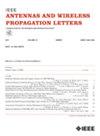双寄生激励导线槽天线的辐射特性
IF 4.8
2区 计算机科学
Q2 ENGINEERING, ELECTRICAL & ELECTRONIC
引用次数: 0
摘要
本文介绍了双寄生激励线缝隙天线辐射特性的推导和验证。首先,推导了导线驱动点处的耦合电流。然后,在通常假设的槽天线和导线电细条件下,分别推导了槽天线和同幅异相激励的两根导线的远场。然后将这些分量组合得到天线的整体辐射场,并推导出天线的指向性。然后,对导线远场的幅值和相位进行计算和分析,得到对缝隙天线远场的抵消。最后,结合两个寄生激发单极子(SCPM)的狭槽天线在E面和h面都实现了均匀的辐射方向图。槽型天线耦合两个寄生激发的反向ls (SCPI)使两个主平面的辐射方向图都变宽,h平面的半功率波束宽度为90°,e平面的半功率波束宽度为88°。此外,与单独使用插槽相比,e平面的元件间相互耦合使SCPW元件降低了约6 dB。为了验证,对SCPM、SCPI及其1 × 2阵列的原型进行了模拟、制作和测量。计算、模拟和测量结果均达到了可接受的一致性。本文章由计算机程序翻译,如有差异,请以英文原文为准。
Radiation Characteristics of a Slot Antenna With Two Parasitically Excited Wires
The formulation and validation of the radiation characteristics of a slot antenna with two parasitically excited wires (SCPW) is presented in this letter. First, the coupled currents at the driving point of wires are derived. Then, the far-fields of a slot antenna and two wires excited with same amplitude but out of phase are derived under the commonly assumed electrically thin condition for the slot and wires, respectively. The antenna’s overall radiation field is then obtained by combining these components and the directivity is deduced. Next, the amplitude and the phase of the far-field of the wires are calculated and analyzed to obtain a cancelation to the far-field of the slot antenna. Finally, the slot antenna coupled with two parasitically excited monopoles (SCPM) achieves uniform radiation patterns in both E- and H-planes. A slot antenna coupled with two parasitically excited inverted-Ls (SCPI) broadens the radiation pattern in both principal planes, resulting in a half-power beamwidth of 90° in the H-plane and 88° in the E-plane. Furthermore, the interelement mutual coupling in the E-plane achieved around 6 dB reduction for SCPW elements compared to using a slot alone. For verification, the prototypes of SCPM, SCPI, and their 1 × 2 arrays were simulated, fabricated, and measured. Acceptable agreements among the calculated, simulated and measured results are achieved.
求助全文
通过发布文献求助,成功后即可免费获取论文全文。
去求助
来源期刊
CiteScore
8.00
自引率
9.50%
发文量
529
审稿时长
1.0 months
期刊介绍:
IEEE Antennas and Wireless Propagation Letters (AWP Letters) is devoted to the rapid electronic publication of short manuscripts in the technical areas of Antennas and Wireless Propagation. These are areas of competence for the IEEE Antennas and Propagation Society (AP-S). AWPL aims to be one of the "fastest" journals among IEEE publications. This means that for papers that are eventually accepted, it is intended that an author may expect his or her paper to appear in IEEE Xplore, on average, around two months after submission.

 求助内容:
求助内容: 应助结果提醒方式:
应助结果提醒方式:


